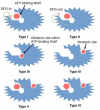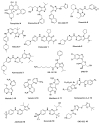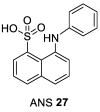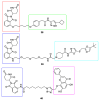Inhibitors of Cyclin-Dependent Kinases: Types and Their Mechanism of Action
- PMID: 33802080
- PMCID: PMC8001317
- DOI: 10.3390/ijms22062806
Inhibitors of Cyclin-Dependent Kinases: Types and Their Mechanism of Action
Abstract
Recent studies on cyclin-dependent kinase (CDK) inhibitors have revealed that small molecule drugs have become very attractive for the treatment of cancer and neurodegenerative disorders. Most CDK inhibitors have been developed to target the ATP binding pocket. However, CDK kinases possess a very similar catalytic domain and three-dimensional structure. These features make it difficult to achieve required selectivity. Therefore, inhibitors which bind outside the ATP binding site present a great interest in the biomedical field, both from the fundamental point of view and for the wide range of their potential applications. This review tries to explain whether the ATP competitive inhibitors are still an option for future research, and highlights alternative approaches to discover more selective and potent small molecule inhibitors.
Keywords: CDK inhibitors; CDKs; cancer; cell cycle; cyclin-dependent kinase inhibitors.
Conflict of interest statement
The authors declare they have no actual or potential competing financial interests.
Figures











Similar articles
-
Structure-based discovery of cyclin-dependent protein kinase inhibitors.Essays Biochem. 2017 Nov 8;61(5):439-452. doi: 10.1042/EBC20170040. Print 2017 Nov 8. Essays Biochem. 2017. PMID: 29118092 Free PMC article. Review.
-
Novel potent pharmacological cyclin-dependent kinase inhibitors.Future Med Chem. 2009 Dec;1(9):1561-81. doi: 10.4155/fmc.09.110. Future Med Chem. 2009. PMID: 21425979 Review.
-
Cyclin-dependent protein kinase inhibitors including palbociclib as anticancer drugs.Pharmacol Res. 2016 May;107:249-275. doi: 10.1016/j.phrs.2016.03.012. Epub 2016 Mar 16. Pharmacol Res. 2016. PMID: 26995305 Review.
-
Cyclin-dependent protein serine/threonine kinase inhibitors as anticancer drugs.Pharmacol Res. 2019 Jan;139:471-488. doi: 10.1016/j.phrs.2018.11.035. Epub 2018 Nov 30. Pharmacol Res. 2019. PMID: 30508677 Review.
-
Development of Inhibitors of Protein-protein Interactions through REPLACE: Application to the Design and Development Non-ATP Competitive CDK Inhibitors.J Vis Exp. 2015 Oct 26;(105):e52441. doi: 10.3791/52441. J Vis Exp. 2015. PMID: 26554946 Free PMC article.
Cited by
-
Design, Synthesis, In Vitro, and In Silico Studies of New N5-Substituted-pyrazolo[3,4-d]pyrimidinone Derivatives as Anticancer CDK2 Inhibitors.Pharmaceuticals (Basel). 2023 Nov 11;16(11):1593. doi: 10.3390/ph16111593. Pharmaceuticals (Basel). 2023. PMID: 38004458 Free PMC article.
-
p27, The Cell Cycle and Alzheimer´s Disease.Int J Mol Sci. 2022 Jan 21;23(3):1211. doi: 10.3390/ijms23031211. Int J Mol Sci. 2022. PMID: 35163135 Free PMC article. Review.
-
Synthesis and In Vitro Anticancer Activity of Novel 4-Aryl-3-(4-methoxyphenyl)-1-phenyl-1H-pyrazolo[3,4-b]pyridines Arrest Cell Cycle and Induce Cell Apoptosis by Inhibiting CDK2 and/or CDK9.Molecules. 2023 Sep 4;28(17):6428. doi: 10.3390/molecules28176428. Molecules. 2023. PMID: 37687256 Free PMC article.
-
Enhancing De Novo Drug Design across Multiple Therapeutic Targets with CVAE Generative Models.ACS Omega. 2024 Oct 18;9(43):43963-43976. doi: 10.1021/acsomega.4c08027. eCollection 2024 Oct 29. ACS Omega. 2024. PMID: 39493989 Free PMC article.
-
Enriching Chemical Space of Bioactive Scaffolds by New Ring Systems: Benzazocines and Their Metal Complexes as Potential Anticancer Drugs.Inorg Chem. 2022 Dec 19;61(50):20445-20460. doi: 10.1021/acs.inorgchem.2c03134. Epub 2022 Dec 6. Inorg Chem. 2022. PMID: 36473464 Free PMC article.
References
-
- Morgan D.O. The Cell Cycle: Principles of Control. 1st ed. New Science Press; London, UK: 2007.
Publication types
MeSH terms
Substances
LinkOut - more resources
Full Text Sources
Other Literature Sources
Medical

